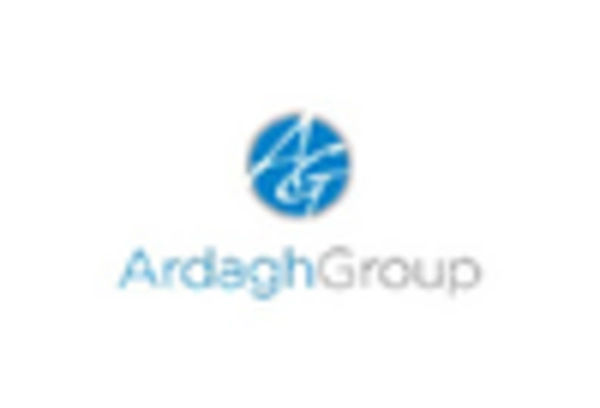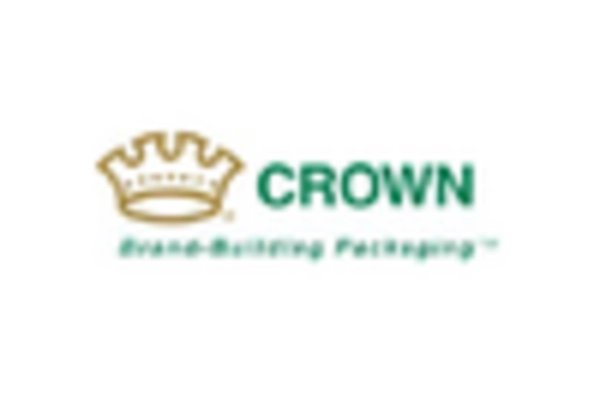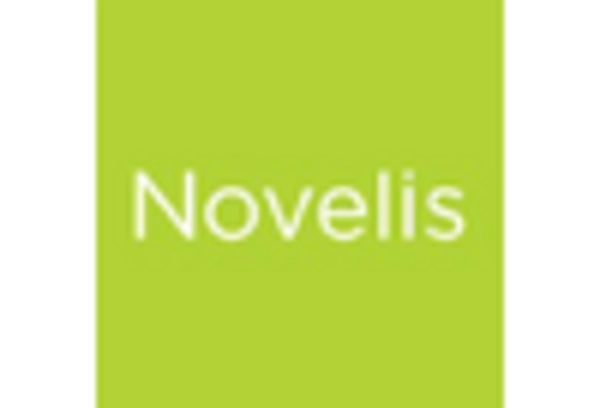Regulatory Incentives for Recycling
The Recycled Aluminum Packaging Market Market is bolstered by regulatory incentives aimed at promoting recycling and reducing waste. Governments are increasingly implementing policies that encourage the use of recycled materials, including tax breaks and subsidies for companies that utilize recycled aluminum in their packaging. Such regulations are designed to minimize landfill waste and promote a circular economy. Market data indicates that regions with stringent recycling mandates have seen a marked increase in the adoption of recycled aluminum packaging, as companies seek to comply with these regulations while also enhancing their sustainability profiles. This regulatory support is likely to continue driving growth in the industry.
Corporate Sustainability Commitments
The Recycled Aluminum Packaging Market Market is significantly influenced by corporate sustainability commitments. Many companies are setting ambitious targets to reduce their carbon footprints and increase the use of recycled materials in their packaging. This trend is driven by both consumer expectations and the desire to enhance corporate reputation. Market data suggests that companies that actively promote their sustainability initiatives experience a positive impact on their brand image and customer loyalty. As more businesses commit to sustainability goals, the demand for recycled aluminum packaging is likely to rise, creating a favorable environment for growth within the industry.
Cost-Effectiveness of Recycled Aluminum
The Recycled Aluminum Packaging Market Market benefits from the cost-effectiveness associated with using recycled materials. The production of recycled aluminum requires significantly less energy compared to primary aluminum, with estimates suggesting a reduction of up to 95% in energy consumption. This translates into lower production costs for manufacturers, making recycled aluminum an attractive option. Furthermore, as energy prices fluctuate, the economic advantages of utilizing recycled aluminum become even more pronounced. This cost efficiency not only supports the profitability of companies within the industry but also encourages wider adoption of recycled aluminum packaging solutions across various sectors.
Technological Innovations in Recycling Processes
The Recycled Aluminum Packaging Market Market is witnessing advancements in recycling technologies that enhance the efficiency and effectiveness of aluminum recovery. Innovations such as improved sorting technologies and automated recycling systems are streamlining the recycling process, resulting in higher quality recycled aluminum. These technological improvements not only increase the yield of recycled materials but also reduce contamination rates, making recycled aluminum more appealing to manufacturers. As these technologies continue to evolve, they are expected to further bolster the market, enabling companies to meet the growing demand for sustainable packaging solutions while maintaining high standards of quality.
Increasing Consumer Demand for Sustainable Packaging
The Recycled Aluminum Packaging Market Market is experiencing a notable surge in consumer demand for sustainable packaging solutions. As environmental awareness rises, consumers are increasingly favoring products that utilize recycled materials. This shift is reflected in market data, indicating that approximately 70% of consumers are willing to pay a premium for products packaged in environmentally friendly materials. Consequently, manufacturers are compelled to adapt their packaging strategies to align with consumer preferences, thereby driving growth in the recycled aluminum sector. The emphasis on sustainability not only enhances brand loyalty but also positions companies favorably in a competitive marketplace, where eco-consciousness is becoming a key differentiator.

















Leave a Comment